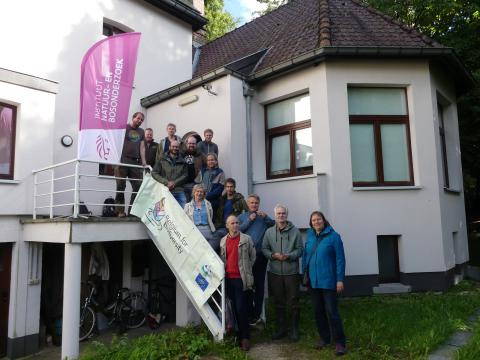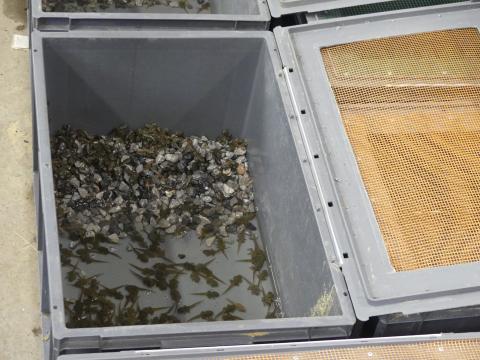





During a networking event on 11 and 12 September 2024, Dutch, German and Belgian nature conservationists met to exchange experiences on the breeding and (re)introduction of Common spadefoot toads. Lessons learned were shared.

From left to right: Jeroen Speybroeck (INBO), Loïc van Doorn (INBO), Christian Göcking (NABU), Johan Meijer (Natuurbalans), Peter Engelen (Natuurpunt), Peter Kroon (Natuurbalans), Lily Gora (ANB), Sebastian Schmidt (Bezirg Regierung Münster), Ian Stevens (Natuurpunt), Bart Hoeymans (ANB), Daan Van Eenaeme (INBO), Jeroen van Leeuwen (Natuurbalans), Martina Raffel (Bezirg Regierung Münster).
In the Netherlands, Belgium/Flanders and western Germany, specifically in North Rhine-Westphalia, Common spadefoot toad is at the westernmost limit of its range. Here, Common spadefoot toad is in an unfavourable conservation status. Loss of habitat, landscape fragmentation and genetic impoverishment due to isolation are the main causes.
Since 2011, several measures have been taken in both the Netherlands and Germany to improve existing habitats to meet Common spadefoot toad habitat requirements. In addition, a breeding and release programme was initiated in both countries to strengthen existing populations and to (re)introduce this toad into former and new suitable habitats. In Germany, this was done with the support of two Life projects: Life+ project ‘Protection of the spadefoot toad in parts of Münsterland’ and Life IP ‘Atlantic Region DE’. 90.000 Common spadefoot toads were released in 40 areas. The Common spadefoot toad currently occurs at 59 sites, which is twice as many as before. Its conservation status has improved from U2 (bad) to U1 (unfavourable-inadequate).
In the Netherlands, a project group was set up in 2011 to develop a 'Common Spadefoot Toad Rescue Plan'. Since then 173.000 Common spadefoot toads were released in 30 different areas by Natuurbalans. In some areas the population increased, in others the population remained stable and in others the population did not recover. Overall, a positive trend in numbers has been observed since the release of Common spadefoot toads in the Netherlands.
In Flanders, the Common spadefoot toad has only been bred and released since 2020, with funding from Life BNIP 'Belgian Integrated Project' until 2023 and currently from Life B4B 'Biodiversity for Belgium'. So far, 40.688 larvae and juveniles have been released in 2 existing and 3 additional areas. Results in Flanders have also been variable so far.
This networking event was the ideal opportunity to exchange experiences and results and to gain an even better understanding of the habitat requirements of Common spadefoot toads. The results so far are encouraging. Monitoring will continue to be important in order to follow the development of the population and to adjust management measures. Cooperation between these partners will continue. The aim is to achieve a favourable conservation status over time.
Here you can also read the news item form LIFE IP Atlantsche Sandlandschaften



